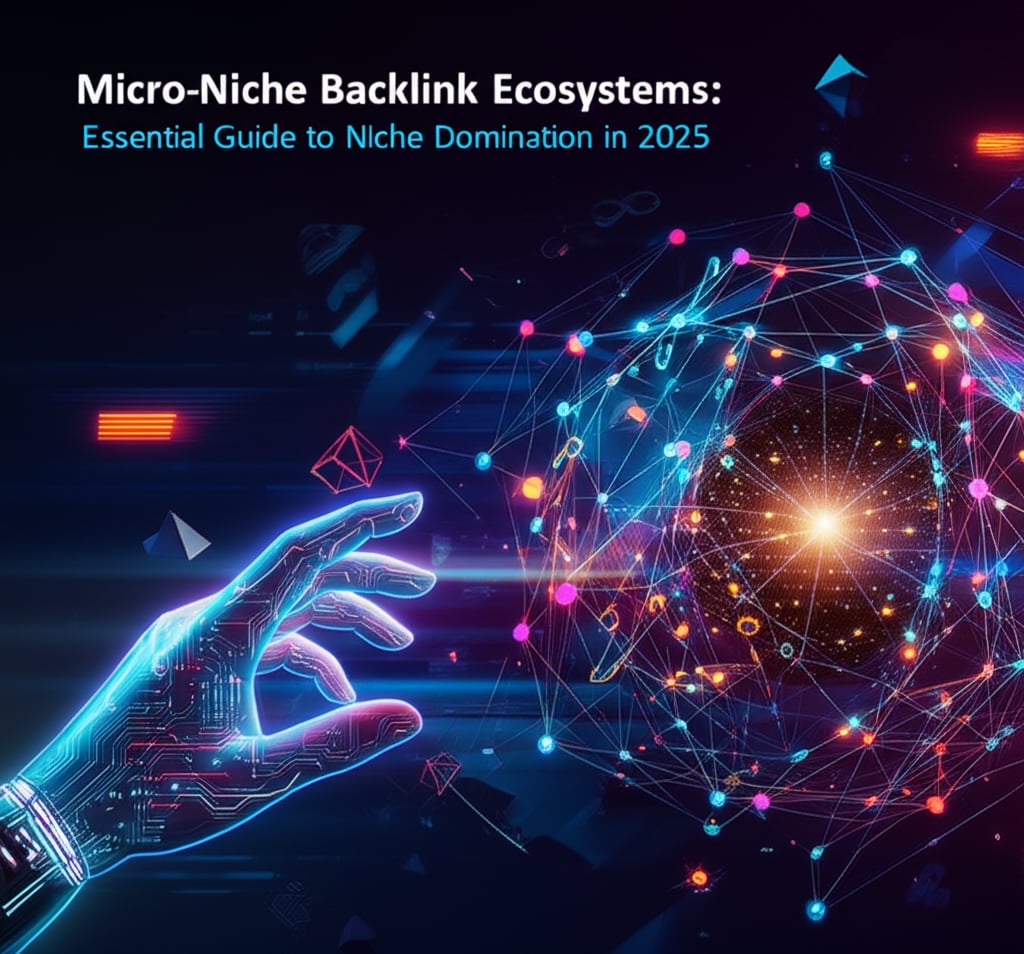Micro-Niche Backlink Ecosystems: Essential Guide to Niche Domination in 2025

In the dynamic and ever-evolving world of search engine optimization, a profound and necessary transformation is actively unfolding. The traditional methodology of generic link building, once a broad-stroke approach that could yield reasonable returns, is now demonstrably suffering from significantly diminishing effectiveness. The trajectory for establishing robust online authority and generating substantial organic traffic is increasingly charting a course toward the meticulous cultivation of micro-niche backlink ecosystems. This highly advanced and nuanced paradigm shifts the focus to fostering hyper-relevant, profoundly contextual connections meticulously woven within exceptionally specific market segments. It’s a strategic imperative that is proving absolutely indispensable for achieving unprecedented niche leadership and unparalleled digital dominance by the year 2025. This sophisticated framework transcends the simplistic act of mere link acquisition; instead, it is about painstakingly constructing an intricate, interwoven tapestry of digital trust and perceived relevance, qualities that modern search engine algorithms actively seek out and profoundly reward. Empirical industry analyses consistently indicate that precisely targeted, quality-driven backlink strategies dramatically outperform high-volume, low-relevance tactics, with pioneering websites showcasing exponential growth trajectories achieved through these highly focused and refined efforts. This isn't just an evolutionary step; it's a revolutionary leap towards precision in the digital landscape.
The Metamorphosis of Backlink Strategy for Ascending to Niche Dominance
Historically, the prevailing philosophy behind backlink cultivation often prioritized sheer quantity over intrinsic quality, with the primary objective being to accumulate a vast volume of inbound links originating from a multitude of diverse web sources. However, as the intricate algorithms underpinning search engines have matured and grown exponentially more sophisticated, their core emphasis has gracefully transitioned. The spotlight has moved decisively towards the triumvirate of profound relevance, unimpeachable authority, and the nuanced understanding of user intent. This pivotal evolution unequivocally necessitates a strategic realignment, a profound pivot towards meticulously constructing an interconnected digital ecosystem of links. Such an ecosystem must authentically and compellingly mirror a website's genuine expertise and the unique value it consistently delivers within its carefully chosen micro-niche. It's no longer enough to just have links; the true objective is to systematically establish thematic authority, a state where every single external link pointing to your site and every internal link within your site cohesively reinforces and amplifies your platform's specialized knowledge and distinct value proposition. This creates a powerful echo chamber of relevance that reverberates through the digital realm.
An exceptionally effective micro-niche ecosystem considers a multitude of critical factors beyond the mere numerical count of incoming links. It scrutinizes their precise thematic alignment with the core subject matter, meticulously evaluates the inherent authority and trustworthiness of the linking domains, and pays exacting attention to the precise context and phrasing of the anchor text used. This highly refined and deliberate methodology guarantees that each individual link contributes genuinely and significantly to the website's perceived authority in the eyes of discerning search engines. By doing so, it unequivocally signals a deep, entrenched relevance and specialized expertise, rather than simply projecting a broad, superficial, or diluted digital presence. Think of it as cultivating a garden where every plant is purposefully selected and contributes to the overall health and vibrancy of the ecosystem, rather than just planting as many seeds as possible.
Key Takeaway: Future-proof search engine optimization absolutely demands a decisive departure from the volume-centric, often indiscriminate, approach to link building. The imperative now is to wholeheartedly embrace a quality-driven, hyper-relevant backlink ecosystem, meticulously crafted to genuinely reflect and project true industry authority and specialized expertise. This is the cornerstone of sustainable online success.
Forging Your Semantic Framework for Unrivaled Hyper-Relevance

Establishing a robust and intelligently designed semantic framework constitutes the bedrock, the very foundational stratum, for any successful micro-niche strategy. This intricate process entails meticulously mapping out the precise contours of your chosen niche, diligently identifying all pertinent core entities, and then structuring your website's content in a manner that profoundly reflects this deep and comprehensive understanding. Consider a real-world case study: a highly successful digital project, which subsequently demonstrated remarkable and sustained revenue growth, meticulously orchestrated its content architecture. This was achieved by precisely defining its central topics and all related entities, thereby creating an impeccably clear and logical hierarchy encompassing main categories, detailed subcategories, and individual, deeply focused articles. This systematic organization allowed for a harmonious flow of information and a clear signaling of thematic depth to search algorithms.
This critical process commences by precisely identifying your primary niche keyword, the very linchpin of your digital identity. Subsequently, it involves exhaustive research into all related entities, concepts, and, crucially, the myriad user intents associated with these terms. Powerful analytical platforms such as Ahrefs prove to be profoundly instrumental in expertly extracting comprehensive and highly granular keyword lists pertinent to each delineated subcategory. The paramount principle here is to intelligently group similar terms and concepts, a strategic maneuver designed to deftly avoid the detrimental phenomenon of content cannibalization. This ensures that each distinct article or content piece is meticulously tailored to target specific, well-defined user queries, thereby optimizing its potential for visibility and relevance. For instance, rather than having three separate articles broadly covering "best coffee makers," "top espresso machines," and "pour-over coffee guides," a semantic framework would cluster these. One comprehensive pillar page might be "Ultimate Guide to Coffee Brewing Methods," with sub-articles delving into "Espresso Machine Reviews for Home Baristas," "Top-Rated Drip Coffee Makers for Busy Mornings," and "Mastering the Art of Pour-Over Coffee." Each sub-article would then target specific long-tail keywords and user intents (e.g., "how to clean espresso machine," "best budget drip coffee maker," "pour-over vs French press"). This ensures a cohesive, authoritative, and interlinked knowledge base.
To truly master this semantic mapping, one must delve beyond mere keyword volume. It involves understanding the relationships between topics, entities (people, places, things, concepts), and actions. Think of Google's Knowledge Graph – your goal is to emulate that interconnectedness on your own site. Tools like Semrush and Surfer SEO can also assist in content clustering and identifying semantically related terms, helping you build a topical authority roadmap. For example, if your micro-niche is "sustainable urban gardening," your core entities might include "hydroponics," "composting," "rainwater harvesting," "vertical gardens," and "native plant species." Each of these entities can become a content cluster, with multiple articles exploring different facets (e.g., "Beginner's Guide to Hydroponic Systems," "Choosing the Right Hydroponic Nutrients," "DIY Hydroponic Setups").
Practical Steps for Semantic Mapping and Content Structuring:
- Define Your Micro-Niche: Go beyond broad definitions. Instead of "gardening," think "small-space organic balcony gardening for apartment dwellers." This specificity guides all subsequent steps.
- Brainstorm Core Concepts & Entities: List all foundational topics, products, services, problems, and solutions within your defined micro-niche. Use mind-mapping tools to visualize connections.
- Conduct Deep Keyword Research: Utilize advanced features of tools like Ahrefs, Semrush, or KWFinder to uncover long-tail keywords, related questions, and "people also ask" queries. Focus on informational, navigational, and transactional intent.
- Identify User Intent Clusters: Group keywords not just by similarity, but by the underlying user intent. Are they looking for information (e.g., "how to fix a leaky faucet"), comparison (e.g., "brand A vs. brand B faucet"), or purchase (e.g., "best kitchen faucet 2024")?
- Develop Pillar Content: Create comprehensive, authoritative "pillar pages" that serve as ultimate guides for a broad topic within your micro-niche. These should be extensive (2,000+ words) and link out to more specific "cluster content." For example, a "Complete Guide to Indoor Herb Gardens" could be a pillar.
- Create Cluster Content: Develop numerous, more focused articles that dive deep into specific aspects mentioned in your pillar content. For the herb garden pillar, clusters could be "Best Grow Lights for Indoor Herbs," "Troubleshooting Common Indoor Herb Pests," or "Harvesting and Storing Fresh Basil." Each cluster article should link back to its pillar page.
- Implement Robust Internal Linking: Crucially, establish a strong internal linking structure between your pillar pages and their corresponding cluster content. This reinforces semantic relationships for search engines and improves user navigation. Use relevant anchor text that clearly indicates the topic of the linked page.
- Leverage Schema Markup: Implement structured data (Schema.org markup) to explicitly tell search engines about the entities on your page, their relationships, and the type of content (e.g., HowTo, Article, Product). This enhances understanding and can lead to rich snippets in search results.
- Monitor and Refine: The semantic framework is not static. Continuously monitor keyword performance, user behavior, and competitor strategies. Update content, create new clusters, and refine your internal linking as your niche evolves. This iterative process ensures enduring relevance.
By meticulously constructing this semantic framework, you are essentially building a detailed, interconnected knowledge base that clearly communicates your expertise to both users and search engines. This deep thematic organization makes your site an undeniable authority in its micro-niche, laying the groundwork for the highly relevant backlink ecosystem that is crucial for sustained dominance.
Crafting High-Value Content for Link Attraction
The foundational premise for attracting high-quality, relevant backlinks within your micro-niche ecosystem is the consistent creation of exceptional, genuinely valuable content. This content must resonate deeply with the specific needs, queries, and interests of your target audience. It must be so inherently useful, so uniquely insightful, or so comprehensively detailed that other authoritative websites and influencers within your niche are compelled to reference, cite, and link back to it organically. This transcends mere article writing; it involves crafting digital assets that solve problems, answer complex questions, offer fresh perspectives, or present novel data.
Examples of such high-value content include:
- Comprehensive Guides & Pillar Pages: As discussed, these serve as definitive resources on a broad topic within your niche, attracting links due to their depth and breadth.
- Original Research & Data Studies: Conducting your own surveys, experiments, or data analysis and publishing the findings can position you as an industry thought leader, making your site a go-to source for statistics and insights.
- Authoritative Case Studies: Detailed accounts of how a particular problem was solved, complete with methodologies, results, and lessons learned, can be invaluable for professionals in your niche.
- Infographics & Visualizations: Complex data or processes simplified into visually appealing formats are highly shareable and often linked as quick references.
- Expert Interviews & Thought Leadership Pieces: Featuring recognized experts or offering unique insights from your own expertise can draw attention and links from those seeking credible sources.
- Tools & Templates: Providing free, useful tools (e.g., a calculator, a checklist generator, a template library) can create massive link bait, as users and other sites will link to them as resources.
The content should not only be rich in information but also impeccably presented, easy to consume, and demonstrate clear E-E-A-T (Experience, Expertise, Authoritativeness, Trustworthiness). This means content written by genuine experts (or demonstrating deep personal experience), thoroughly researched, clearly cited where necessary, and presented on a secure, well-designed website. When your content genuinely solves a problem or fills a knowledge gap, it becomes an undeniable magnet for highly relevant links, forming the organic bedrock of your micro-niche backlink ecosystem.
Strategic Link Outreach and Relationship Building

Once your robust semantic framework is in place and you are consistently producing high-value, link-worthy content, the next phase involves proactive and highly strategic link outreach. This is not about spamming; it’s about forging genuine relationships and demonstrating the inherent value of your content to potential linking partners. The goal is to identify authoritative and highly relevant websites within your micro-niche or adjacent niches that would genuinely benefit from referencing your content.
Effective outreach goes far beyond generic emails. It requires:
- Hyper-Targeted Prospecting: Instead of looking for any site that accepts guest posts, identify sites that regularly cover topics directly related to your content. Use competitor backlink analysis (tools like Ahrefs, Semrush) to find sites linking to similar content, or use Google search operators to find resource pages, industry blogs, and professional associations.
- Personalized Communication: Every outreach email should be unique. Reference a specific piece of their content, explain why your content would be a valuable addition for their audience, and make it clear you're familiar with their work. Avoid sounding like a sales pitch.
- Value Proposition: Clearly articulate the benefit to them. Will your link add more depth to their article? Will it provide a missing piece of information for their readers? Is it a more up-to-date resource?
- Relationship Building: Think long-term. Instead of just asking for a link, consider offering something in return: sharing their content on social media, providing a unique insight for their next article, or collaborating on a future project. Nurturing these relationships can lead to a continuous stream of highly relevant links.
- Diverse Link Acquisition Tactics:
- Broken Link Building: Find broken links on authoritative sites within your niche and offer your relevant, intact content as a replacement.
- Resource Page Link Building: Identify "resources" or "recommended readings" pages on relevant sites and suggest your content for inclusion.
- Unlinked Mentions: Use tools to find instances where your brand or content has been mentioned without a link, and politely request attribution.
- Guest Posting (Strategic): If a site is highly relevant and authoritative, offer to write a high-quality guest post that naturally incorporates a link back to your site. This should be quality over quantity.
- HARO (Help a Reporter Out): Respond to queries from journalists looking for expert sources. This can lead to high-authority media mentions and links.
- Podcast Appearances/Interviews: Being a guest on a relevant podcast can lead to links from the podcast's website and expose your brand to a new audience.
The key to successful link outreach in a micro-niche ecosystem is its precision and authenticity. Every link acquired should feel like a natural endorsement, a deliberate choice by a relevant authority, rather than a forced insertion. This meticulous approach ensures that each new link amplifies your semantic authority and contributes meaningfully to your niche dominance, cementing your position as a trusted and indispensable resource.
Measuring Success and Adapting Your Ecosystem
The journey towards building a resilient micro-niche backlink ecosystem is an ongoing process that demands continuous monitoring, analysis, and strategic adaptation. Success is not merely measured by an increase in the raw number of backlinks, but by a holistic evaluation of the ecosystem's health, impact, and contribution to your overall niche dominance.
Key metrics and activities for measurement and adaptation include:
- Organic Traffic Growth: This is the ultimate barometer. Is your carefully constructed ecosystem translating into increased organic visitors, particularly for your targeted micro-niche keywords? Track trends over time using Google Analytics or Search Console.
- Keyword Rankings: Monitor your SERP positions for your core pillar keywords and long-tail cluster keywords. Look for improvements in rankings and an expansion of the number of keywords you rank for, especially in the top 10 positions.
- Domain Authority/Rating (DR/DA): While third-party metrics, they provide an indication of your site's overall link equity and authority. Track their progression, understanding that quality links from higher DR/DA sites will have a more significant impact.
- Referring Domains: Focus on the number of unique referring domains rather than just the total number of links. A higher number of unique, relevant domains signals a broader and more diverse endorsement.
- Link Quality Metrics: Regularly audit your backlink profile. Assess the relevance, authority, and health of new and existing links. Disavow toxic or irrelevant links that could harm your ecosystem.
- Engagement Metrics: Beyond traffic, look at user engagement: bounce rate, time on page, pages per session. High engagement signals that your content is truly meeting user intent, which reinforces your semantic authority.
- Conversion Rates: Ultimately, if your micro-niche strategy is working, it should lead to improved conversion rates (e.g., leads, sales, sign-ups) as you attract highly qualified, intent-driven traffic.
- Competitor Analysis (Ongoing): Regularly analyze the backlink profiles and content strategies of your top competitors within the micro-niche. Identify gaps in their content, potential link opportunities they are exploiting, and areas where you can differentiate and outperform them.
- Algorithm Updates: Stay abreast of major search engine algorithm updates. Analyze their impact on your site and adjust your strategy accordingly. A strong, relevant ecosystem is more resilient to these shifts.
- Content Refresh & Expansion: Your content needs to stay fresh and comprehensive. Periodically review your pillar and cluster content for accuracy, completeness, and freshness. Update statistics, add new sections, or expand on topics to maintain its value and attract new links.
By diligently tracking these metrics and proactively adapting your strategy based on the insights gained, you ensure that your micro-niche backlink ecosystem remains vibrant, potent, and continuously optimized for unparalleled dominance. This iterative process of creation, promotion, measurement, and refinement is the engine that drives sustainable growth and cements your status as the definitive authority in your specialized corner of the digital world. The journey of niche domination is not a sprint, but a meticulously planned and expertly executed marathon, where every relevant link acts as a powerful stride forward.